[2011] 1 SLR 727 - Singapore Law
[2011] 1 SLR 727 - Singapore Law
[2011] 1 SLR 727 - Singapore Law
Create successful ePaper yourself
Turn your PDF publications into a flip-book with our unique Google optimized e-Paper software.
[<strong>2011</strong>] 1 <strong>SLR</strong> SINGAPORE LAW REPORTS <strong>727</strong>Galsworthy Ltd of the Republic of LiberiavGlory Wealth Shipping Pte Ltd[2010] SGHC 304High Court — Originating Summons No 337 of 2010(Registrar’s Appeal No 267 of 2010)Choo Han Teck J29 July; 12 August; 14 October 2010Arbitration — Enforcement — Foreign award — Party resisting award challengedfinal award in supervisory jurisdiction — Challenge in supervisory jurisdictiondismissed for failure to furnish security for costs — Whether party resisting awardwas entitled to make application to set aside order granting leave to enforceArbitration — Enforcement — Foreign award — Tribunal’s finding on the marketrate — Whether order granting leave to enforce final award should be set aside —Sections 31(2) and 31(4) International Arbitration Act (Cap 143A, 2002 Rev Ed)FactsThe defendants, Glory Wealth Shipping Pte Ltd (“GWS”), chartered a vesselfrom the plaintiffs, Galsworthy Limited of the Republic of Liberia(“Galsworthy”). In turn, GWS sub-chartered the vessel to a third party. Bothcharters were not performed and the disputes were referred to separate LondonArbitrations, and each tribunal constituted to hear each arbitration comprisedthe same set of arbitrators. Two final awards were issued but only one set ofreasons was issued. This case concerned the final award pertaining to the charterbetween GWS and Galsworthy.Galsworthy’s claim against GWS in the London Arbitration was for, inter alia,hire and damages arising from GWS’s failure to perform the Head Charter, withdamages to be quantified by the difference between the charter party rate and themarket rate at or around the date of termination for the remaining approximatecharter period. On 14 October 2009, the tribunal issued a final award againstGWS for the sum of US$1,114,406.82 and US$39,393,745.03 for hire anddamages respectively (“the Final Award”).On 23 December 2009, GWS applied to challenge the Final Award pursuant toss 68(2)(a)–68(2)(c) and 69 of the Arbitration Act 1996 (c 23) (UK) (“the UKAct”) in the English court. With respect to the s 68 application, Galsworthyapplied on 26 January 2009 for security for costs, and its application was grantedon 15 March 2010. GWS was ordered to provide £30,000 in security within eightdays from the date of the order. GWS did not do so and their applicationchallenging the Final Award was dismissed on 25 March 2010. There was nohearing on the merits. In so far as the s 69 application was concerned, GWSappealed against the Final Award on a point of law. That appeal was dismissedon 16 February 2010. The English High Court was of the view that the Tribunal’sdecision was right.
728 SINGAPORE LAW REPORTS [<strong>2011</strong>] 1 <strong>SLR</strong>On 6 April 2010, Galsworthy came to the <strong>Singapore</strong> courts and obtained leave toenforce the Final Award. On 5 May 2010, GWS applied to set aside the ordergranting leave to enforce. The application was heard on 23 June 2010 anddismissed by the assistant registrar on 2 July 2010.Dissatisfied with the decision, GWS appealed. Three grounds were raised. First,GWS argued that the Final Award contained a decision on the matter beyondthe scope of the submissions to arbitration (see s 31(2)(d) of the InternationalArbitration Act (Cap 143A, 2002 Rev Ed) (“the IAA”)). Second, the arbitralprocedure was not in accordance with the agreement of the parties (sees 31(2)(e) of the IAA). Third, the enforcement of the Final Award would becontrary to the public policy of <strong>Singapore</strong> (see s 31(4)(b) of the IAA).Held, dismissing the appeal:(1) GWS was not entitled to make this application since it had elected toproceed in the English courts, and the application here to set aside the ordergranting leave to enforce amounted to an abuse of process. GWS had theopportunity in choosing either the supervisory or enforcement court to mountits challenge. It elected to proceed on the former, and the grounds relied on byGWS in the s 68 application in the English Court were exactly the same as thoserelied on by GWS in the appeal. As it turned out, Galsworthy successfullyapplied and obtained an order for security for costs in the amount of £30,000.Since security was not furnished, the s 68 application was dismissed. GWS’application was therefore a considered decision on their part to avoid the need tofurnish security to the English court. GWS had elected their forum of challengeand they ought to be bound by it. GWS ought to have either furnished securityas directed or appealed against that order. It was the principle of comity ofnations that required our courts to be slow to undermine the orders made byother courts unless exceptional circumstances existed. None existed here.Furthermore, if the application here was allowed, it could result in a duplicationor conflict of judicial orders: at [8] and [9].(2) In the alternative, and assuming that GWS was entitled to make anapplication to set aside the order granting leave to enforce on the merits, GWShad not sufficiently established the three grounds they asserted on appealpursuant to ss 31(2) and 31(4) of the IAA. For the first ground, GWS submittedthat the award contained a decision on the matter beyond the scope of thesubmissions to arbitration. The essence of GWS’s complaint was the Tribunal’seventual finding on the market rate of the charter for the purposes ofquantifying the damages. There was no basis in their complaint. The issue ofdamages was submitted to the Tribunal for a decision which it duly made. It wasGWS themselves who asked for damages to be assessed according to a figure ofUS$12,000 in the event that they were liable. The second ground raised by GWSwas that the arbitral procedure was not in accordance with the agreement of theparties. GWS argued that the finding made by the Tribunal was based onevidence erroneously transposed from the Sub-Charter arbitration onto theHead Charter arbitration. There was no substance in GWS’ complaint sinceGWS themselves requested for the reference they now complain about. GWShad agreed for the Head Charter arbitration and Sub-Charter arbitration to beheard concurrently, and that led to the Tribunal issuing an order for a
[<strong>2011</strong>] 1 <strong>SLR</strong>Galsworthy Ltd of the Republic of Liberia vGlory Wealth Shipping Pte Ltd 729concurrent hearing of the two arbitrations. Furthermore, it was GWS themselveswho had consistently adopted the submissions and evidence of the subcharterer,and this practice was expressly extended to the expert evidence fromthe sub-charterer. Third, GWS argued that the enforcement of the award wouldbe contrary to the public policy of <strong>Singapore</strong>. This ground was based on s 31(4)of the IAA but the substance of this ground was identical to those raised in thepreceding two grounds. Those contentions made by GWS were without basisand it was unnecessary to consider the consequential issue of whether thesecontentions met the high threshold required under s 31(4). Even assuming thatGWS’s complaints had the necessary evidential basis, those complaints did notoffend any notion of justice and morality, or amounted to exceptionalcircumstances to justify a refusal of enforcement: at [12], [14], [15] and [17].[Observation: There were two stages regarding enforcement proceedings; thefirst stage of enforcement pertained to the initial grant of leave to enforce, andthe second stage of enforcement whereby a party to whom an award was madeagainst resisted the enforcement based on the grounds set out in the IAA. Thereference in Aloe Vera America, Inc v Asianic Food (S) Pte Ltd [2006] 3 <strong>SLR</strong>(R)174 to a “mechanistic process” referred to the first stage and not the secondstage. With regard to the second stage, it was clear from the express wording ofs 31(2) that a party ought to prove the grounds relied on a balance ofprobabilities, as was held in Strandore Invest A/S v Soh Kim Wat [2010] SGHC151 (“Strandore”). The comments made in Strandore endorsed the abovebifurcated analysis, and standards required in each stage ought not to beconflated with each other. The law concerning the two-stage process was thesame before and after Strandore: at [11].]Case(s) referred toAloe Vera America, Inc v Asianic Food (S) Pte Ltd [2006] 3 <strong>SLR</strong>(R) 174; [2006]3 <strong>SLR</strong> 174 (refd)Dallah Estate and Tourism Holding Co v Ministry of Religious Affairs of theGovernment of Pakistan [2010] 2 WLR 805 (refd)Hainan Machinery Import and Export Corp and Donald & McArthy Pte Ltd, ReAn Arbitration Between [1995] 3 <strong>SLR</strong>(R) 354; [1996] 1 <strong>SLR</strong> 34 (refd)Hebei Export Corp v Polytek Engineering Co Ltd [1999] 2 HKC 205 (refd)Newspeed International Ltd v Citus Trading Pte Ltd [2003] 3 <strong>SLR</strong>(R) 1; [2003]3<strong>SLR</strong> 1 (refd)Strandore Invest A/S v Soh Kim Wat [2010] SGHC 151 (refd)Legislation referred toInternational Arbitration Act (Cap 143A, 2002 Rev Ed) s 31(2) (consd);ss 31(2)(d), 31(2)(e), 31(4), 31(4)(b)Arbitration Act 1996 (c 23) (UK) ss 33, 68, 68(2)(a), 68(2)(b), 68(2)(c), 69Song Swee Lian Corina and Bryna Yeo Li Neng (Allen & Gledhill LLP) for theappellant/defendant;Kevin Kwek and Corrine Taylor (Legal Solutions LLC) for the respondent/plaintiff.
730 SINGAPORE LAW REPORTS [<strong>2011</strong>] 1 <strong>SLR</strong>14 October 2010Choo Han Teck J:1 This was an appeal by the defendants, Glory Wealth Shipping Pte Ltd(“GWS”), against the decision of Assistant Registrar Peh Aik Hin (“theAR”) dismissing their application made under ss 31(2) and 31(4) of theInternational Arbitration Act (Cap 143A, 2002 Rev Ed) (“the IAA”) to setaside an order of court dated 6 April 2010. That order gave the plaintiffs,Galsworthy Limited of the Republic of Liberia (“Galsworthy”), leave toenforce an arbitral award in <strong>Singapore</strong>. I dismissed the appeal and now givemy reasons.2 By a time charter dated 7 May 2008 (“the Head Charter”), GWSchartered a vessel Jin Tong (“the Vessel”) from Galsworthy for a periodbetween 60 to 63 months and at a rate of US$35,500 per day. GWS in turnsub-chartered the Vessel to Worldlink Shipping Limited (“Worldlink”)under a time charter dated 11 July 2008 (“the Sub-Charter”) for a periodbetween 14 to 16 months. Both charters were, however, not performed andthis gave rise to the disputes that were referred to separate LondonArbitrations; ie, between Galsworthy and GWS pursuant to the HeadCharter and between GWS and Worldlink pursuant to the Sub-Charter.The Tribunal (“the Tribunal”) constituted to hear each arbitrationcomprised the same set of arbitrators and although two final awards wereissued by the Tribunal, only one set of reasons was issued because theTribunal was of the view that many of the issues concerned were commonto both arbitrations.3 Galsworthy’s claim against GWS in the London Arbitration was for,inter alia, hire and damages arising from GWS’s failure to perform theHead Charter, with damages to be quantified by the difference between thecharter party rate and the market rate at or around the date of terminationfor the remaining approximate charter period of four years and10.5 months (17 December 2008 to 31 October 2013). The time charter andthe dispute were governed by English law. No oral hearing was conductedand the arbitration was determined solely on written submissions. On14 October 2009, the Tribunal issued the final award (“the Final Award”)against GWS for the sum of US$1,114,406.82 and US$39,393,745.03 for hireand damages respectively. These figures were derived from the Tribunal’sfinding that that the applicable market rate for an equivalent fixture wasUS$11,000 per day.4 On 23 December 2009, GWS applied to challenge the Final Awardpursuant to ss 68(2)(a)–68(2)(c) and 69 of the Arbitration Act 1996 (c 23)(UK) (“the UK Act”) in the English court. In so far as the s 68 grounds wereconcerned, counsel for GWS argued that the Tribunal’s finding on theapplicable market rate was wrong, and as a result, the Tribunal failed tocomply with its general duty in s 33 (see s 68(2)(a)). Further, that the
[<strong>2011</strong>] 1 <strong>SLR</strong>Galsworthy Ltd of the Republic of Liberia vGlory Wealth Shipping Pte Ltd 731Tribunal exceeded its powers (see s 68(2)(b)), and finally, that the Tribunaldid not conduct the proceedings in accordance with the procedure agreedby the parties (see s 68(2)(c)). In response to the application, Galsworthyapplied on 26 January 2009 for security for costs, and its application wasgranted on 15 March 2010. GWS was ordered to provide £30,000 in securitywithin eight days from the date of the order, GWS did not do so and theirapplication was thus dismissed on 25 March 2010. There was no hearing onthe merits. In so far as the s 69 grounds were concerned, GWS appealedagainst the Final Award on a point of law. That appeal was dismissed on16 February 2010. The English High Court was of the view that theTribunal’s decision was right.5 On 6 April 2010, Galsworthy came to the <strong>Singapore</strong> courts andobtained leave to enforce the Final Award. On 5 May 2010, GWS applied toset aside the order granting leave to enforce. The application was heard on23 June 2010 and dismissed by the AR on 2 July 2010.6 GWS raised three grounds in the appeal before me. First, it arguedthat the Final Award contained a decision on the matter beyond the scopeof the submissions to arbitration (see s 31(2)(d) of the IAA). Second, thearbitral procedure was not in accordance with the agreement of the parties(see s 31(2)(e) of the IAA). Third, the enforcement of the Final Awardwould be contrary to the public policy of <strong>Singapore</strong> (see s 31(4)(b) of theIAA).7 In the hearing before the AR below, a preliminary dispute arosebetween the parties as to whether the defendant was entitled to apply to setaside the order granting leave to enforce the arbitration award since GWShad already made an application in the English courts; ie, a s 68 applicationunder the UK Act challenging the award on grounds of irregularity, and as 69 application under the UK Act for an appeal on a point of law. Aspointed out by the parties, a party seeking to challenge an arbitration awardhas two courses of action open to him; he can either apply to thesupervising court to set aside the award, or, he can apply to the enforcementcourt to set aside any leave granted to the opposing party to enforce theaward. These options were alternatives and not cumulative. See NewspeedInternational Ltd v Citus Trading Pte Ltd [2003] 3 <strong>SLR</strong>(R) 1, which was latercited with approval in Aloe Vera America, Inc v Asianic Food (S) Pte Ltd[2006] 3 <strong>SLR</strong>(R) 174 (“Aloe Vera”). In the present case, GWS chose tochallenge the Final Award (see [4] above) and applied to set it aside beforethe supervising court. It was not disputed that the grounds stated in the s 68application were similar to those in this appeal. That application before theEnglish court was not heard because GWS did not furnish security. The s 69application was dismissed. The AR at the hearing below was of the view thatthe GWS was still entitled to take up the application to set aside the leave toenforce the award and he proceeded to hear the application on the merits.
732 SINGAPORE LAW REPORTS [<strong>2011</strong>] 1 <strong>SLR</strong>8 On this point, however, I was of the view that GWS was not entitled tomake this application since it had elected to proceed in the English courts,and the application here to set aside the order granting leave to enforceamounted to an abuse of process. Although Galsworthy did not appealagainst the AR’s findings on the preliminary dispute, I was entitled toreview that decision de novo and furthermore during oral submissions,Galsworthy argued that this was an additional ground to dismiss GWS’sappeal. GWS had the opportunity in choosing either the supervisory orenforcement court to mount its challenge. It elected to proceed on theformer. As it turned out, Galsworthy successfully applied and obtained anorder for security for costs in the amount of £30,000. Since security was notfurnished, the s 68 application was dismissed. Two affidavits were filed insupport of its application here to set aside the leave to enforce, but they didnot explain why security was not furnished in the English court. Counselfor Galsworthy pointed out that the grounds relied on by GWS in the s 68application in the English court were exactly the same as those relied on byGWS in the present appeal.9 I was therefore of the view that the GWS application to set aside theorder granting leave to enforce was a considered decision on their part toavoid the need to furnish security to the English court. This was not a casewhere the party resisting an award voluntarily withdrew its appeal at thesupervising court to mount a challenge at the enforcement court. GWS hadelected their forum of challenge and they ought to be bound by it. GWSought to have either furnished security as directed or appealed against thatorder. It is the principle of comity of nations that requires our courts to beslow to undermine the orders made by other courts unless exceptionalcircumstances exist. None existed here. Furthermore, if the application herewas allowed, it could result in a duplication or conflict of judicial orders.Obviously, if GWS’s s 68 application was heard on the merits and failed,they would be entitled to challenge the enforcement of the final award inthe enforcement court if the grounds and standards between thesupervising and enforcement jurisdiction are different.10 In the alternative, and assuming that GWS was entitled to make anapplication to set aside the order granting leave to enforce on the merits, Iwas not convinced that GWS had sufficiently established the three groundsthey asserted on appeal pursuant to ss 31(2) and 31(4) of the IAA. In so faras the s 31(2) grounds are concerned, it is clear from the express wording ofthe statutory provision that GWS, a party resisting the enforcement of theforeign award, bore the burden of proving to this court that the groundsthey relied on had been proved. Both counsel agreed on this, but theydisagreed as to the standard applicable for such an application. Counsel forGWS submitted that the enforcement of the Final Award is not automaticand that a full hearing of the relevant issues before our courts ought to beallowed. In support of this view, she cited Quentin Loh JC’s decision in
[<strong>2011</strong>] 1 <strong>SLR</strong>Galsworthy Ltd of the Republic of Liberia vGlory Wealth Shipping Pte Ltd 733Strandore Invest A/S v Soh Kim Wat [2010] SGHC 151 (“Strandore”), whichadopted the English Court of Appeal decision in Dallah Estate and TourismHolding Company v Ministry of Religious Affairs of the Government ofPakistan [2010] 2 WLR 805 (“Dallah”). In contrast, Galsworthy took theview that our jurisdiction adopted a “mechanistic” attitude towards theenforcement of these foreign awards and that our courts should notconsider the merits of the foreign award. Counsel for Galsworthy citedJudith Prakash J’s decision in Aloe Vera in support.11 The submissions implied that the decisions in Strandore and AloeVera ([7] supra) were in conflict since the former seemed to have madesome reservations on the latter. However, the material portions of thosedecisions actually concerned different issues and I did not see any conflictas a result. The relevant portions of Strandore are as follows:22 I now turn to the law. Aloe Vera of America, Inc v Asianic Food (S) PteLtd and another [2006] 3 <strong>SLR</strong>(R) 174 (‘Aloe Vera’) lays down the rule that theenforcement of a foreign arbitration award under s 30 IAA and O 69Ar 6 RSC, is a mechanistic process. All the applicant seeking enforcement hasto do is to produce the arbitration agreement, prove that the defendant wasmentioned in the arbitration agreement exhibited by the applicant, and thatan Arbitral Tribunal had made a finding that the defendant was a party tothat agreement and that the Arbitral Tribunal had made an award againsthim, exhibiting the duly authenticated original award or a duly certified copythereof. It does not require a judicial investigation by the court enforcing theaward under the IAA, the examination that the court must make of thedocuments under O 69A r 6 RSC is a formalistic and not substantive one.Section 31(1) IAA supports this approach. This approach has also beenendorsed recently in Denmark Skibstekniske Konsulenter A/s I Likvidation(formerly known as Knud Hansen A/S) v Ultrapolis 300 Investments Ltd(formerly known as Ultrapolis 3000 Theme Park Investments Ltd[2010] SGHC 108, (‘DSK v Ultrapolis’). A distinction is drawn between thefirst stage under s 30 and the second stage under s 31.23 With great respect to two very experienced judges, I have myreservations, especially on Aloe Vera, and how far the approach that isadvocated is consistent with other cases, including the recent English Courtof Appeal decision in Dallah Estate and Tourism Holding Company v TheMinistry of Religious Affairs, Government of Pakistan [2009] EWCA Civ 755,(‘Dallah Estate’). The judge at first instance stated that when a party ischallenging the jurisdiction of an arbitral tribunal under s 103(2) of theEnglish Arbitration Act 1996, (which is the equivalent of our s 31(2) IAA),and that party is, by the very words of that section, required to ‘prove’ amatter, that must mean prove the existence of the relevant matters on abalance of probabilities. That exercise is, to that extent, a rehearing, not areview.As correctly pointed out by both counsel and the AR below, there are twostages regarding enforcement proceedings; the first stage of enforcementpertains to the initial grant of leave to enforce, and the second stage of
734 SINGAPORE LAW REPORTS [<strong>2011</strong>] 1 <strong>SLR</strong>enforcement whereby a party to whom an award was made against resiststhe enforcement based on the grounds set out in the IAA. The reference inAloe Vera to a “mechanistic process” referred to the first stage and not thesecond stage. With regard to the second stage, it is clear from the expresswording of s 31(2) that a party ought to prove the grounds relied on abalance of probabilities, as was held in Strandore. The comments made inStrandore endorsed the above bifurcated analysis, and standards required ineach stage ought not to be conflated with each other. I agree. The lawconcerning the two-stage process was the same before and after Strandore.The standards submitted by counsel for GWS and Galsworthy were bothcorrect but they were examining different provisions. In so far as this appealwas concerned, both sides acknowledged that the enquiry involved thesecond stage of the enforcement proceedings, and it cannot be disputed thatGWS bore the burden of proving the grounds in s 31(2) it relied on, on abalance of probabilities.12 Three related grounds were raised, but all without basis. Under thefirst ground, GWS submitted that the award contained a decision on thematter beyond the scope of the submissions to arbitration. The principalcomplaint was that the Tribunal was presented with evidence byGalsworthy in the arbitration that there was no market existing for theVessel at the date of the termination of the Head Charter. Counsel for GWSargued that the Tribunal acknowledged the absence of a market in itsReasons for the Award (at [28] to [29] of the Tribunal’s decision), itnevertheless proceeded to find that the applicable market rate wasUS$11,000 daily. GWS argued that Galsworthy had the burden of provingdamages, and since the normal measure of recovery in cases of prematuretermination of a charterparty is the difference between the contractual ratefor the balance of the charter period and the market rate, Galsworthy’sfailure to establish a market and market rate was naturally fatal to its claimfor damages. GWS was thus compelled to claim that the Tribunal’s decisionwas based on facts or arguments not presented by or discussed by parties.13 In response, counsel for Galsworthy argued that one of the issues tobe determined by the Tribunal was the amount of damages to be awardedand it was GWS (and affirmed by the Tribunal subsequently) thatsubmitted that the market rate of US$12,000 on a daily basis be used in theevent that the Tribunal was to hold that Galsworthy was entitled todamages. Galsworthy made the observation that GWS was attempting tore-litigate the issues in dispute and were asking the <strong>Singapore</strong> court todetermine the merits of the Final Award.14 In my view, the essence of GWS’s complaint was the Tribunal’seventual finding on the market rate of the charter for the purposes ofquantifying the damages. The issue of damages was submitted to theTribunal for a decision which it duly made. It was GWS themselves whoasked for damages to be assessed according to a figure of US$12,000 in the
[<strong>2011</strong>] 1 <strong>SLR</strong>Galsworthy Ltd of the Republic of Liberia vGlory Wealth Shipping Pte Ltd 735event that they were liable. I therefore found no basis in their complaint. Incounsel’s closing submissions for GWS to the Tribunal, it was submitted:19. Further or alternatively, if (which is denied) it is held that Owners areentitled to damages, Charterers submit that Owners’ damages should beassessed in accordance with a market rate of US$12,000. In this regard,Charterers refer to the supplementary report of Lewis Chartering Limited(Bundles pages 438 – 441) which concludes that if Owners had taken actionearlier in November 2008 when the Vessel was first rejected, it would havebeen possible to secure a fixture at a higher rate than that which Ownersobtained when the Vessel was only refixed in January 2009. Accordingly,Owners have failed to properly mitigate their loss in waiting until December2009 to offer the Vessel for fixture. [emphasis added]In my view, since GWS had already addressed this issue before theTribunal, they cannot now say that the eventual decision was outside thescope of the parties’ case.15 The second ground raised by GWS was that the arbitral procedurewas not in accordance with the agreement of the parties. This argument wassimilar to the first point, GWS argued that the finding made by the Tribunalwas based on evidence erroneously transposed from the Sub-Charterarbitration onto the Head Charter arbitration. The Tribunal relied on asupplementary report prepared by Worldlink’s expert in the Sub-Charterarbitration pertaining to the market rate to be used to calculate theappropriate damages. GWS also argued that the supplementary report wasconfined solely to the issue of mitigation of damages, and that the Tribunalgrossly misinterpreted and wrongly accepted that report as evidence fromGWS of the market rate. Galsworthy’s case was that GWS had agreed forthe Head Charter arbitration and Sub-Charter arbitration to be heardconcurrently, and that led to the Tribunal issuing an order for a concurrenthearing of the two arbitrations. Furthermore, it was GWS themselves whohad consistently adopted the submissions and evidence of the sub-chartererWorldlink, and this practice was expressly extended to the expert evidencefrom Worldlink. In my view therefore, there was no substance in GWS’complaint since GWS themselves requested for the reference they nowcomplain about.16 GWS also took the alternative position on appeal that this US$12,000submission ought to be confined to its submission that Galsworthy hadfailed to mitigate its losses. I found this argument to be also without basisbecause GWS’ submission (as set out in [14] above) clearly referred to it asdamages and not mitigation. The only reason GWS could make thisargument on appeal was that they consolidated their arguments on thequantification of damages and the failure to mitigate in a single paragraph.In any event, the issues of assessment of damages and the duty to mitigatewere inextricably linked, and GWS could not argue one and not the other.
736 SINGAPORE LAW REPORTS [<strong>2011</strong>] 1 <strong>SLR</strong>17 Third, counsel for GWS argued that the enforcement of the awardwould be contrary to the public policy of <strong>Singapore</strong>. This ground was basedon s 31(4) of the IAA but the substance of this ground was identical to thoseraised in the preceding two grounds; namely that the Tribunal failed todecide the matter in accordance with the facts and evidence presented bythe parties, and additionally, that the Tribunal erroneously transposed theevidence used in the Sub-Charter arbitration. As I have held above, thosecontentions made by GWS were without basis and it was unnecessary forme to consider the consequential issue of whether these contentions metthe high threshold required under s 31(4). Even if I were to assume thatGWS’s complaints had the necessary evidential basis, I did not find thatthose complaints offended any notion of justice and morality (see HebeiExport Corp v Polytek Engineering Co Ltd [1999] 2 HKC 205), or amountedto exceptional circumstances to justify a refusal of enforcement (see Re AnArbitration Between Hainan Machinery Import and Export Corp andDonald & McArthy Pte Ltd [1995] 3 <strong>SLR</strong>(R) 354 at [45]). As I saw it, GWS’sunhappiness was with the amount of damages awarded by the Tribunal,and not their liability arising from the failed charter. GWS had theopportunity to, and did address the Tribunal on the appropriatequantification of damages and the Tribunal had taken their submissionsinto account. Even if I had accepted that there was no existing market todetermine the market rate, the Tribunal could not be faulted for attemptingto find the best evidence on record to determine the market rate to be usedin the quantification of damages. In my view therefore, GWS’s unhappinesswith the Tribunal’s decision, without more, was not a sufficient basis toprevent an application for the enforcement of the foreign award.18 On account of the above, I dismissed GWS’s appeal and ordered costsfixed at $2,000 with reasonable disbursements to be awarded to Galsworthy.Reported by Darryl Soh.


![[2011] 1 SLR 727 - Singapore Law](https://img.yumpu.com/51140774/1/500x640/2011-1-slr-727-singapore-law.jpg)
![[1983-1984] SLR(R) 447 - Artic Builders & Co - Singapore Law](https://img.yumpu.com/50909204/1/164x260/1983-1984-slrr-447-artic-builders-co-singapore-law.jpg?quality=85)
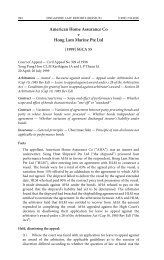
![[1996] 2 SLR(R) 292 - Lim Eng Hock Peter v ... - Singapore Law](https://img.yumpu.com/47482222/1/164x260/1996-2-slrr-292-lim-eng-hock-peter-v-singapore-law.jpg?quality=85)

![[2006] 1 SLR(R) 197 - PT Asuransi Jasa Indonesia - Singapore Law](https://img.yumpu.com/46425352/1/164x260/2006-1-slrr-197-pt-asuransi-jasa-indonesia-singapore-law.jpg?quality=85)
![[1985-1986] SLR(R) 503 - Woh Hup (Pte) - Singapore Law](https://img.yumpu.com/45676364/1/164x260/1985-1986-slrr-503-woh-hup-pte-singapore-law.jpg?quality=85)
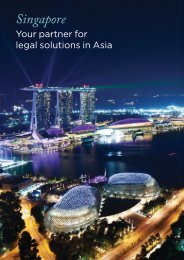
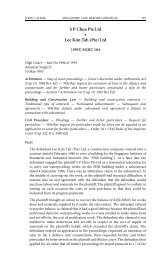
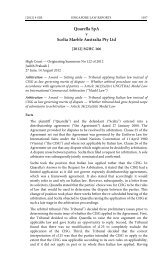
![[2010] 2 SLR 821 - Singapore Law](https://img.yumpu.com/43145563/1/166x260/2010-2-slr-821-singapore-law.jpg?quality=85)
![[2007] 1 SLR(R) 597 - PT Asuransi Jasa Indonesia - Singapore Law](https://img.yumpu.com/42983489/1/164x260/2007-1-slrr-597-pt-asuransi-jasa-indonesia-singapore-law.jpg?quality=85)
![[1989] 1 SLR(R) 433 - Singapore Law](https://img.yumpu.com/42649524/1/164x260/1989-1-slrr-433-singapore-law.jpg?quality=85)
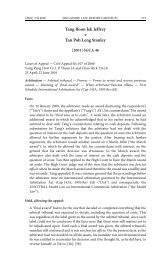
![[1997] 3 SLR(R) 360 - Singapore Law](https://img.yumpu.com/42287507/1/164x260/1997-3-slrr-360-singapore-law.jpg?quality=85)